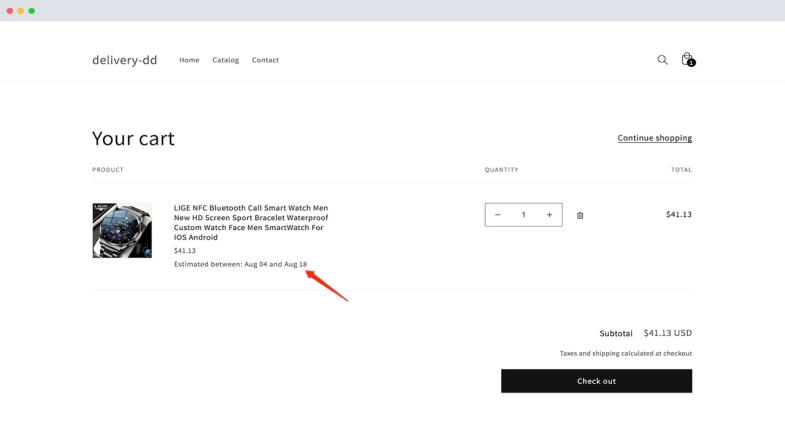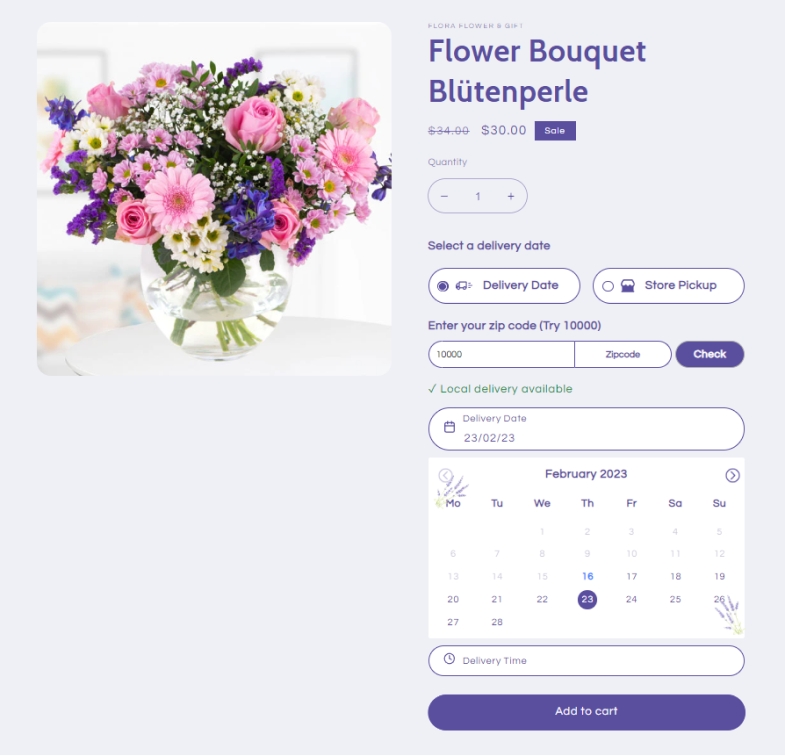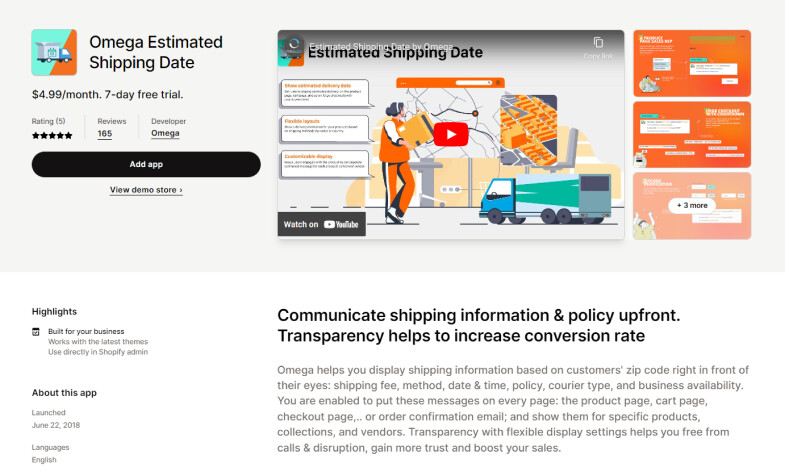📅Making the Holidays Hassle-Free: The Importance of Delivery Date

The holiday season is a time of joy, celebration, and gift-giving. But it can also be a time of stress, disappointment, and frustration, especially when it comes to shopping. One of the biggest challenges of holiday shopping is trying to coordinate purchases, shipping, and delivery dates to ensure that gifts arrive on time.
Therefore, accurately displaying delivery date is essential for holiday shopping success, as it not only helps shoppers plan ahead, avoid disappointment, and make informed purchasing decisions, but also assists merchants to build trust, increase conversion rates, and improve customer satisfaction.
In this blog, we'll explore the various benefits of showing delivery dates during the holidays, and why it's critical for retailers to be transparent about their delivery schedules. So, whether you're a shopper or a retailer, read on to learn more about the importance of delivery dates in the holiday season.
Definition of Delivery Date
A delivery date (delivery arrival date), is the estimated or confirmed date when a package, shipment, or order will reach the recipient. Retailers often communicate this information on product pages, cart pages, or checkout pages.
If they have a clear understanding of delivery schedules, they can provide a confirmed delivery date. However, if they cannot guarantee a specific date, they may offer a delivery window that indicates the likely arrival time.

In today's competitive e-commerce landscape, retailers are looking for ways to differentiate themselves and stand out from the crowd. One way to achieve this is by offering flexible delivery options that allow customers to choose a delivery window that works for them. By balancing customer flexibility with their own availability, retailers can offer a delivery experience that is both convenient and personalized. This not only gives customers more control over the delivery process but also enhances their overall shopping experience.

Some factors affect to Delivery Date
Once we have an understanding of delivery dates, we can see that they can either be accurate or estimated and can be set by the e-commerce site owner or chosen by the buyers themselves. However, there are various external factors that retailers cannot control, such as shipping delays and unpredictable circumstances like inclement weather. Therefore, in this article, we will focus on fulfillment factors that retailers can partially estimate and control to provide their customers with a reasonable delivery window.
Here are several factors during the fulfillment process that impact delivery dates and times:
Lead time
Lead time is the amount of time that passes from the start of a process until its conclusion.
The general formula to calculate lead time:
Lead time=pre-processing time + processing time + post-processing time
Pre-processing time refers to the time needed to prepare raw materials, perform certain procedures, or move products from available storage to unavailable storage, which is where shipping is typically located.
Processing time is the time required to prepare an order for shipment, which can include cooking, packaging, and manufacturing.
Post-processing time is the shipping time, which is the time it takes for the order to reach its destination after leaving the warehouse. By breaking down these different types of processing times, retailers can better manage their order fulfillment process and provide more accurate delivery estimates to their customers.
Let's take a bakery that sells birthday cakes as an example:
To fulfill an order, the bakery needs 1 business day for both preparing the materials and making the cake, and another business day for shipping. It then takes an additional 2 business days for the cake to arrive at the customer's doorstep. In this scenario, the lead time would be 2 business days.
📌 It's important to note that lead times can vary between businesses and industries. However, it's crucial to consider all relevant factors in order to provide accurate delivery dates and estimates.
Cut-off time
Cut-off times refer to the specific times of day when vendors stop fulfilling orders for that day. These times work in conjunction with lead times to allow vendors enough time to prepare and ship orders. If a customer places an order after the cut-off time, it will not be processed until the following working day, causing a delay in delivery.
To ensure timely delivery, customers should be informed of the cut-off time and encouraged to place orders before that time. Vendors should also take cut-off times into account when calculating delivery windows to guarantee on-time delivery and meet their customers' expectations.
Working days
Working days are the days of the week that a business operates, typically Monday through Friday, but this can vary depending on the specific business and industry.
It's crucial to consider the working days of the store, as it can have an impact on the order delivery time. For instance, if a store is closed on weekends and a buyer places an order on Friday night after the cut-off time, the order won't be processed until the following Monday, leading to a delay in delivery.
Therefore, buyers should be mindful of the store's working days and place orders accordingly, while retailers should also take store availability into account when calculating delivery windows to ensure accurate and timely delivery estimates.
Backout dates/Holidays
Blackout dates or holidays are unexpected or seasonal periods during which businesses cannot fulfill orders such as Christmas or New Year's Day. When orders cannot be fulfilled due to blackout dates, the expected delivery date will be adjusted to account for the lost time. This means that the processing and delivery time for orders will be extended to accommodate the blackout period.
To ensure timely delivery, buyers should be aware of upcoming blackout dates and plan their orders accordingly. Vendors, on the other hand, should factor in blackout dates when estimating delivery times to provide accurate delivery estimates to their customers. By working together to consider blackout dates, buyers and vendors can help ensure a smoother and more efficient order fulfillment process.
Why showing Delivery Date is important for any holiday

Buyers
Helps to manage expectations and avoid disappointment
Shopping online has its advantages, but two factors that can deter customers are the inability to touch and see the product before purchasing and the waiting period for the order to arrive. It is crucial for retailers to effectively communicate delivery dates and times to help customers manage their expectations and avoid any potential disappointment. This also helps customers plan their schedule accordingly, preventing any inconvenience or worry about receiving their order on time. Clear communication about delivery dates and times is a key aspect of ensuring customer satisfaction in online shopping.
Enables better planning
With delivery dates, buyers can better plan when to order, when to expect delivery, and can avoid any last-minute panic.
be a part of your customer's special occasion by allowing them to give that perfect gift at the most ideal moment
Retailers
Build trust
Clear communication of delivery dates is crucial to building customer trust and boosting conversion rates, especially during the holidays. In addition to the price, timely fulfillment and delivery are key factors that can impact buyers' decisions. By providing reliable delivery information, vendors can prove their dedication to meeting customers' expectations and enhance trust, leading to increased repeat business.
Enhance customer satisfaction
By providing clear delivery dates, vendors can improve the customer experience and ensure their customers are satisfied with their service.
Reduces customer inquiries:
Providing delivery dates can reduce the number of customer inquiries and complaints, as customers will know when to expect their orders, and won't need to contact the merchants for updates.
How to show Delivery Date for Shopify online store
Delivery Date given by merchants
There are various options available for online retailers to display delivery dates on their stores. One of the most recommended solutions is Omega Estimated Shipping Date.
With a 7-day trial and a monthly cost of $4.99, this app allows merchants to clearly communicate all the essential shipping information to their customers, including delivery dates and times, shipping fees, policies, and business availability.
They can tailor these messages for specific products, collections, and vendors and display them on every page of the website, from product pages to checkout and order confirmation pages.
With flexible display settings and complete transparency, Omega Estimated Shipping Date helps retailers gain more trust from their customers, avoid disruption and calls, and ultimately boost their sales.

Delivery Date chosen by customers
Customers often prefer to have control over when they receive their orders, for various reasons such as security, sales, or holiday planning. Allowing buyers to choose their delivery date and time is a great way to cater to this need and boost customer satisfaction.
DingDoong is a perfect solution for delivery and pickup planning, with a user-friendly date picker that lets customers select their preferred delivery time.
The app is free to use for up to 20 orders and allows you to calculate the right delivery date by setting factors such as lead times, cut-off times, working days, blackout dates, limit order.
DingDoong also offers flexibility to merchants, who can decide where they want to deliver and set flat shipping rates based on various conditions such as zip code, order value, and weight. The app provides an all-in-one solution that makes delivery planning a breeze for both merchants and customers.

Take advantage of DingDoong's features and get started with your delivery planning today!
Final notes on Delivery Date
Don't let delivery delays ruin the holiday shopping experience.
By paying attention to delivery dates and planning ahead, buyers can ensure that their orders arrive on time and avoid the stress and disappointment of late deliveries.
Meanwhile, merchants can provide accurate delivery estimates and factor in lead time, cut-off time, working days, and blackout dates to show their reliability and commitment to customer satisfaction.
So whether you're buying or selling, make sure to collaborate and communicate clearly with one another about delivery dates to ensure a successful and enjoyable shopping experience for all involved.
Last updated
Was this helpful?